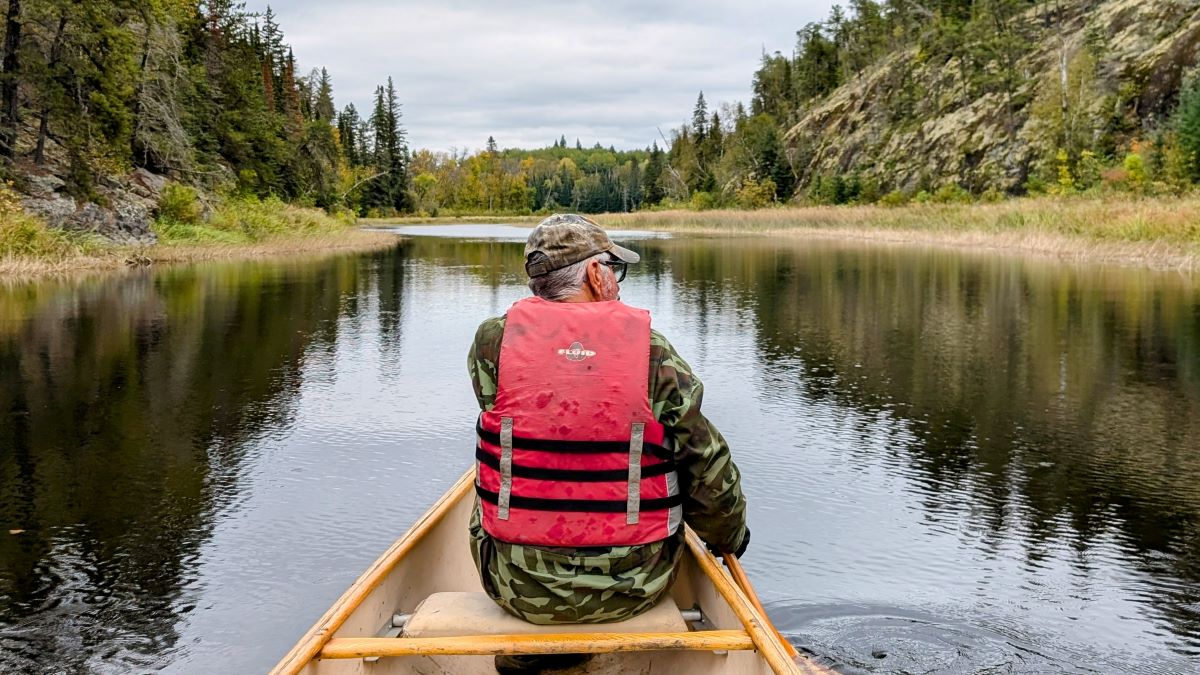The Bird River and protecting the wild

There are few Manitoba experiences as peaceful as drifting along a calm boreal river in a canoe. And that’s exactly what we did for World Rivers Day this year. The Wilderness Committee, joined by 40 excited volunteers, created some memories this September as we paddled the Bird River in Sagkeeng First Nation territory. This waterway provides us with lessons of what we’ve preserved in this province… and what remains at risk.
My parents took me up to Nopiming Provincial Park on my first canoe trip in 1976, mere months after the park was first designated. Growing up we spent a lot of time in Nopiming, but also in Hollow Water First Nation territory along the Wanipigow. Ahead of World Rivers Day, my dad joined me to clear the portage trails on the lower Bird River. He’s spent more than five decades visiting this area to paddle and experience undisturbed nature, bringing people to see the boreal beauty and reminiscing about past adventures.

Sharing the wonder of the wild is why I brought a group of exchange students from Chile up to the Bird River on the Saturday of World Rivers weekend. Many folks are astonished that the area east of Lake Winnipeg, including Nopiming Provincial Park, is part of the largest intact forest on the planet. The Chilean teenagers and their local host students experienced this wonderful wilderness as they paddled upstream from Tulabi Lake, in one of the few protected areas in Nopiming Park.
My high school graduation trip paddled here in the 1990s. The route remains as wild as it was many years ago, and is still the most popular canoe trip in the province. This is where you show off Manitoba to the world.
When we arrived at the first portage I pointed out the large stairs up the muddy embankment from the river, which the Wilderness Committee helped install more than a decade ago. Making a more enjoyable wild experience should be part of the work we do as a province. One of the tenets of our Grow Parks philosophy is to expand people-powered trails. How many canoes have been safely carried up and over to make more wild memories since we improved this path? There are immense gains to be made through protected areas work.

The Sunday World Rivers Day trip took folks down the lower Bird River, a route we’ve been paddling since Tanco Mines threatened to flood the Bird with contaminated water from their Bernic Lake operation 11 years ago.
In the time since we started the Paddle for Protection, there has been a wave of change, but not towards the preservation of this iconic river. The entire lower Bird River has been claimed by private entities for mining and a massive land grab is underway for “critical minerals”.
Luckily, the lower Bird River survived during years of environmental destruction brought on by a Progressive Conservative provincial government, as witnessed by the devastation of Nopiming Park for mining.
We are one year into a shiny new government, with a charismatic Premier keen to be seen doing good things. But it’s time to acknowledge that the NDP government in Manitoba is abysmal and absent in one of their only election environmental promises: they are not growing parks and protected areas. The first budget from this government in April allocated no money for the arduous work of preserving 30 per cent of the province by 2030, instead spending more money to disrupt parks for mining activity.
While I have much to complain about regarding threats to the lower Bird, for my lunch break talk I chose to discuss how wild this waterway is, and how important wild is to us. Never has the understanding of wild been more important than it is now. We can’t make wild and wilderness, we can only lose wilderness. And so the lower Bird River is only ours to lose. We’ll never make another river like it, filled with functioning relationships between birds, fishes, animals and trees. Our view of wildness as essential for society must be uplifted as we face the coming challenges.
The world has agreed we need to grow protected areas to 30 per cent in order to halt biodiversity decline. But biodiversity is wildness, and wildness is the lower Bird River. This river has to be top on the list for areas to protect in Manitoba. Decades ago we agreed to protect the upper Bird River — an icon in the province and a gateway to the heart of the boreal. The lower Bird River is that special, that enduring, that wild… it’s what protected areas are designed to preserve. The lower Bird River must be preserved. It must be designated and cared for according to the wishes of Sagkeeng First Nation, and it will be a path where we feel our wild and share our wild.
Use this letter writing tool to Help Protect the lower Bird River.